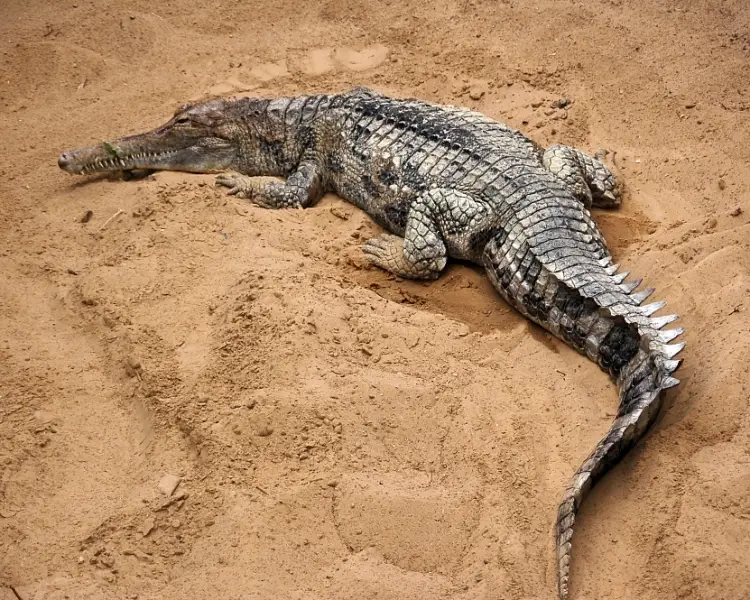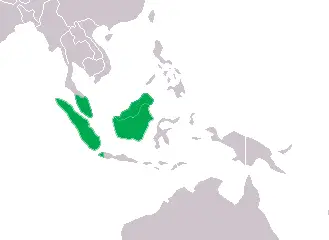Malay Gavial (Tomistoma schlegelii) – one of the least studied and unique crocodile-like predators in the world. This reptile has narrow and long jawsimilar to the jaws of the Gangetic gavial (Gavialis gangeticus), but it is genetically closer to real crocodiles.
The Malay Gavial inhabits swamps and slow rivers of Southeast Asiain particular, Malaysia, Indonesia and Brunei. Through deforestation, swamp drainage and poaching, this species is now threatened with extinction.
Let's consider structure, behavior, habitat and ecological significance this rare predator.

Scientific classification
🔬 Taxonomy of the Malay Gavial:
✔ The Kingdom: Animals (Animalia)
✔ Type: Chordal (Chordata)
✔ Class: Reptiles (Reptilia)
✔ Row: Crocodile-like (Crocodylia)
✔ Family: Crocodile trees (Crocodylidae)
✔ Gender: Tomistomas (Tomistoma)
✔ View: Malay Gavial (Tomistoma schlegelii)
📌 Interesting!
Despite its similarity to Gangetic gavial, Malay Gavial refers to families of real crocodiles (Crocodylidae), and not to the gavialovs (Gavialidae).
Evolution and origin
🦖 When did gavials appear?
* Tomistoma's ancestors are believed to have lived even earlier . 100 million years ago.
* In the past, Gavials inhabited wide areas of Europe, Asia and Africa.
• Tomistoma schlegelii there is the last representative of your group, which previously included many different types.
📌 Interesting!
Recent genetic studies have shown that the Malay gavial is closer to true crocodiles than to gavials. This means that its long jaw is the result of convergent evolution, and not of common origin with gavials.
Description and features
💠 What does the Malay gavial look like?
• Length: 4-5 m, less often to 5.5 m.
• Weight: 150-200 kg, individuals can reach up to 250-300 kg.
• Jaw: Narrow, long, with a large number of sharp teeth (up to 84 teeth).
• Body: Muscular, elongated, dark brown with dark spots.
• Eyes and nostrils: They are located high on the head, which helps to sit in the water.
📌 How is it different from other crocodiles?
✅ Has narrow jaw, adapted to fishing.
✅ Closer to crocodiles than gavials, although it looks similar to the latter.
✅ Able to hunt more than just fish, but also on larger animals.

Range and habitat
🌍 Where does the Malay gavial live?
This type occurs only in Southeast Asia, separately:
✅ Malaysia
✅ Indonesia (Sumatra, Kalimantan)
✅ Brunei
✅ Thailand (considered missing in the wild)
🔹 What places of residence does he choose?
✅ Swamps, mangroves, peat boggy forests
✅ Slow-moving rivers with dense vegetation
✅ Lakes with a rich fish population
📌 Interesting!
Malay gavial doesn't like open water ta tries to stay in remote, swampy regions where it is difficult to find it.

Lifestyle and behavior
🔹 Hunting and nutrition
Malay gavial – highly specialized predatorthat it is capable of hunting a wider range of prey than the Gangetic gavial.
🍽 What does it eat?
✅ Fish - the main part of the diet
✅ Amphibians - frogs, newts
✅ Birds - waterfowl ducks
✅ Mammals - monkeys, rodents, young deer
📌 How does he hunt?
* Uses narrow jaw for quick grabbing of fish.
• Sits in the water she sharply attacks the prey.
• It hunts mainly at night.
📌 Interesting!
The Malay gavial is more aggressive than the Gangetic Gavial and can attack large animals.
Reproduction and development
💡 How does the Malay Gavial breed?
* Females lay eggs 20-60 eggs at the nest on the banks of swamps.
* Incubation continues 75-90 days.
* Cubs hatch in length 25-30 cm.
* Mothers sometimes protect the nest, but generally care less for their young than other crocodiles.
📌 Interesting!
Tomistoma eggs – some of the largest among crocodiles, they reach 9 cm in length.

Threats and security
⚠ What threatens Malay gavial?
• Deforestation of tropical forests and drainage of swamps
• Water pollution
• Poaching
• Random catch in fishing nets
🛡 Security status:
, Enabled in IUCN Red List with the status "Vulnerable" (VU).
✅ Protected laws of Indonesia and Malaysia.
сохранения Conservation programs work to restore the population.
📌 Interesting!
Because of its remote habitat, scientists still don't know much about the abundance and behavior of this species.
Conclusion
Malay gavial – one of the most mysterious and rare reptiles in Asia.
💡 Basic facts:
✔ Has unique narrow jaw, similar to gavial.
✔ There are a closer relative of crocodilesthan gavialov.
✔ Lives in remote swamps and mangroves.
✔ Needs protection because of the disappearance of natural habitats.
📢 Malay gavial is a "living ghost" of tropical swamps that we must preserve for future generations!